Viruses - chickpea
Contributors to this page: ICRISAT, India (RP Thakur, AG Girish, VP Rao); ICARDA, Syria (Siham Asaad, Abdulrahman Moukahal).
|
Contents: |
Scientific Name
Pea Seedborne Mosaic Virus (PSbMV).
Other scientific names
Pea fizzle top virus, pea leaf rolling virus, pea leaf roll mosaic virus, pea leaf rolling mosaic virus.
Significance
PSbMV is of economic importance in pea, faba bean and lathyrus, mainly due to its effect on seed quality. It has been mistakenly considered to be a minor disease because it often causes only minor yield loss and mild symptoms. However, at the International Centre for Agriculture in the Dry Areas (ICARDA), Syria, glasshouse studies on yield losses due to PSbMV in chickpea, faba bean, lentil and pea showed losses of 66%, 40.5%, 44.6% and 49.2% respectively. Surveys of pulse crops over a number of years showed that up to 15% of crops were infected with PSbMV, with a within crop incidence of up to 5% of plants. In surveys in WA in 1999, PSbMV was found in 42% of field pea crops and the level of virus detected in pea seed stocks was up to 63%. The surveys in WA indicated that PSbMV has a severe effect on seed quality of pulse crops with seed coat symptoms evident on >80% of faba bean, >50% of lathyrus species and field peas and 5% of chickpea seed.
Symptoms
The disease is characterized by a mild mottling on the leaves.
The affected plants are reduced in growth, which is easily recognized, especially when they are compared with healthy plants. Yield reductions of 15-16% could occur in some different cultivars. Seeds from infected plants occasionally show dark staining on the seed.
Plants may show no symptoms or there may be chlorosis in new shoots, mottling on leaves, shoot tip necrosis and stunting of plants.
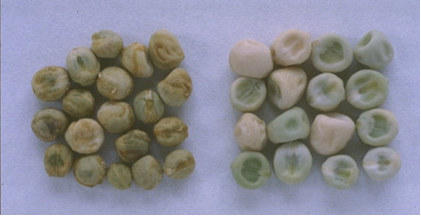 PSbMV (photo: www1.agric.gov.ab.ca) |
Hosts
The natural host range of PSbMV is limited to the Fabaceae. It infects temperate pulses (chickpea, faba bean, field pea, lentil) other legumes (garden pea, narbon bean) and pastures (lathyrus and vetch). A number of PSbMV pathotypes have been recognised by their ability to infect a number of pea differential genotypes.
Geographic distribution
Cosmopolitan.
Biology and transmission
The virus is believed to have spread worldwide through the exchange of infected seed. Seed transmission rates of up to 100% in peas and up to 44% in lentils have been reported. In Victoria, we have detected PSbMV at low levels in some commercial chickpea seedlots (0.4% of seed) and at higher levels in field pea and lentil seedlots (greater than 2% of seed). In the USA, 3% PSbMV infection in pea seedlots and 32-40% in lentil seedlots have been reported. At ICARDA, PSbMV was found to be transmitted through lentil seeds at rates of up to 44%. PSbMV is also transmitted in a non-persistent manner by more than 20 aphid species and by mechanical means. The most efficient vector is the pea aphid (Acyrthosiphon pisum). The other species are as follows: A. pelargoni, A. sesbaniae, Aphis craccivora, A. fabae, A. gossypii, A. nasturtii, Aulacorthum circumflexum, A. solani, Brevicoryne brassicae, Cryptomyzus ribis, Dactynotus escalantii, Macrosiphum avenae, M. euphorbiae, M. pisi, M. rosae, Metopolophium dirhodum, Myzus persicae, Ovatus crataegarius, Phorodon cannabis, Rhopalosiphum padi and Semiaphis dauci. In Victorian pulse crop surveys, we have found cowpea aphid (Aphis craccivora), foxglove aphid (Aulacorthum solani) and green peach aphid (Myzus persicae), which are all vectors of PSbMV.
Detection/indexing method in place at the CGIAR Centres
- At ICARDA - Not important. TBIA, Enzyme-linked immunosorbent assay (ELISA), Tissue blot immunoassay (TBIA).
- At ICRISAT - Not applicable.
Treatment
- Seed is considered to be the main source of PSbMV, therefore sowing virus tested seed is the most effective way of controlling this virus. Commercial seed tests are available.
- Chemical control of aphids is not an effective method for controlling non-persistently transmitted viruses, such as PSbMV. Pulse crops should be sown away from other legumes to minimize the spread of PSbMV.
References and further reading
http://www.icarda.org/Publications/Field_Guides/Lentil/Lent7.Html
http://image.fs.uidaho.edu/vide/descr575.htm
http://www1.agric.gov.ab.ca/$department/deptdocs.nsf/all/prm7819
http://www.inra.fr/hyp3/pathogene/6psbmov.htm
Scientific Name
Alfalfa Mosaic Virus (AMV).
Other scientific names
Lucerne Mosaic Virus, Potato Calico Virus.
Significance
The studies showed that up to 17% of crops were infected with AMV, with a within-crop incidence of up to 21% of plants.
Symptoms
Chlorosis of the terminal bud and twisting, followed by necrosis and the subsequent proliferation of secondary branches. Such new secondary branches are stiff and erect with smaller leaflets that show a mild mottle.
Very few pods are produced.
Terminal bud necrosis can also be caused by iron deficiency but proliferation of branches is not seen in iron deficient plants.
Hosts
The host range of AMV is wide and not limited to Fabaceae. Temperate pulse hosts include chickpeas, faba beans, field peas, lentils, narbon beans, grass peas and vetch. Pasture legume hosts include lucerne, burr medic and other annual medics and a number of clover species.
Geographic distribution
Algeria, India, Iran, Morocco, New Zealand and USA.
Biology and transmission
The virus is transmitted by a vector; transmitted by mechanical inoculation; transmitted by grafting; not transmitted by contact between hosts; transmitted by seeds (50% in alfalfa seeds from individual infected plants and up to 10% in commercial seed, transmitted by pollen to the seed).
Vector Transmission
The virus is transmitted by arthropods, by insects of the order Hemiptera, family Aphididae; Myzus persicae and at least 13 other species. The virus is transmitted in a non-persistent manner.
Detection/indexing method in place at the CGIAR Centres
- At ICARDA- Not important. Enzyme-linked immunosorbent assay (ELISA), Tissue blot immunoassay (TBIA).
- At ICRISAT- Not applicable.
Treatment
- Chemical control of aphids is not an effective method for controlling AMV.
- Sowing healthy seed, managing weeds and other cultural practices to minimize AMV spread are recommended.
- Growing crops adjacent to infected lucerne or pasture will increase the risk of crop infection.
Procedure followed at the CGIAR Centres in case of positive test
No specific procedures notified.
References and further reading
http://www.icrisat.org/vasat/learning_resources/chickpea/chickpea_diseases/viral_mosaic.htm
http://www.ncbi.nlm.nih.gov/ICTVdb/ICTVdB/00.010.0.01.001.htm
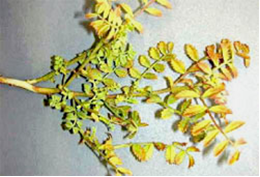 |
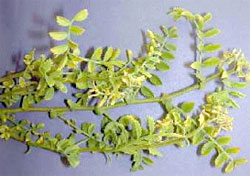 |
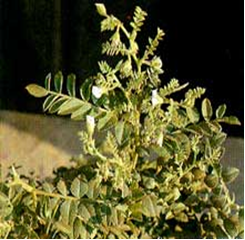 |
|
AMV (photos: www.dpi.vic.gov.au) |
||
Bean Yellow Mosaic, Narrow leaf
Scientific Name
Bean Yellow Mosaic Virus (BYMV).
Other scientific names
Bean Virus 2, Canna Mosaic Virus.
Significance
BYMV is sometimes found in faba bean crops and occasionally in peas with within crop virus incidences of 1-15% and up to 7% respectively.
Symptoms
Yellowing and drying of the plants with feathery and deformed leaves are common.
The leaves below the proliferated branches turn yellow, show interveinal chlorosis, or mosaic depending on the genotype tested. The overall height of the plant is reduced.
Affected plants produce very few, distorted flowers that develop into very small pods.
The seeds from infected plants are black, small, and shriveled.
 BYMV (photo: www.icrisat.org) |
Hosts
The host range of BYMV is wide and not limited to Fabaceae. The virus is reported to infect nearly 200 species in 14 families. Temperate pulse hosts include chickpeas, faba beans, field peas, lentils and lupins. Temperate legume pasture hosts include lathyrus, lucerne, vetch and medic and clover species. BYMV has a number of subtropical and tropical pulse hosts, including soybeans, peanuts and French beans as well as legume pasture hosts. It also infects ornamental hosts, the most common being gladiolus species.
Geographic distribution
The virus is probably distributed worldwide.
Biology and transmission
The virus is transmitted by a vector. The virus is transmitted by mechanical inoculation; and transmitted by seeds up to 3%.
Vector Transmission:
Virus is transmitted by arthropods, by insects of the order Hemiptera, family Aphididae; more than 20 ssp. including Acyrthosiphon pisum, Macrosiphum euphorbiae, Myzus persicae, Aphis fabae. Virus is transmitted in a non-persistent manner.
Detection/indexing method in place at the CGIAR Centres
- At ICARDA - Not important. Enzyme-linked immunosorbent assay (ELISA), Tissue blot immunoassay (TBIA).
- At ICRISAT - Not applicable.
Treatment
- Chemical control of aphids is not an effective method for controlling non-persistently transmitted viruses such as BYMV.
- Pulse crops should be sown away from legume pastures to minimize the spread of BYMV.
- The spread of virus can also be reduced by controlling weed hosts from in and around paddocks.
Procedure in place at the CGIAR Centres in case of positive test
No specific procedures notified.
References and further reading
http://www.icrisat.org/vasat/learning_resources/chickpea/chickpea_diseases/viral_narrowleaf.htm
http://www.ncbi.nlm.nih.gov/ICTVdb/ICTVdB/00.057.0.01.009.htm
Cucumber Mosaic, Proliferation
Scientific Name
Cucumber Mosaic Virus (CMV).
Other Scientific Names
Banana Infectious Chlorosis Virus, Cleus Mosiac Virus.
Significance
In field experiments infection in chickpea was shown to diminish shoot dry weight by 72-81%, seed yield by 80-90% and individual seed yield by 17-25%.
Symptoms
Bushy and stunted plants.
Diseased plants produce few flowers and pods, and many die prematurely.
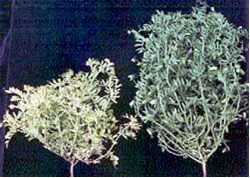 CMV (photo: ICARDA) |
Hosts
Susceptible host species are found in the families: Amaranthaceae, Apocynaceae, Chenopodiaceae, Compositae, Convolvulaceae, Cruciferae, Cucurbitaceae, Leguminosae-Papilionoideae, Malvaceae, Phytolaccaceae, Polygonaceae, Scrophulariaceae, Solanaceae, Tetragoniaceae, Tropaeolaceae, Umbelliferae.
Geographic distribution
The virus is probably distributed worldwide.
Biology and transmission
The virus is transmitted by a vector; the virus is transmitted by mechanical inoculation; it is transmitted by seeds (in 19 species but in variable extents).
Vector Transmission
The virus is transmitted by arthropods, by insects of the order Hemiptera, family Aphididae; more than 60 subspecies including Acyrthosiphon pisum, Aphis craccivora and Myzus persicae. The virus is transmitted in a non-persistent manner.
Detection/indexing method in place at the CGIAR Centres
- At ICARDA - Not important. Enzyme-linked immunosorbent assay (ELISA), Tissue blot immunoassay (TBIA).
- At ICRISAT - Not important.
Treatment
- Chemical control of aphids is not an effective method for controlling CMV.
- Sowing healthy seed, managing weeds and other cultural practices to minimize CMV spread are recommended.
- Growing crops adjacent to infected lucerne or pasture will increase the risk of crop infection.
Procedure followed at the centers in case of positive test
No specific procedures notified.
References and further reading
http://www.icrisat.org/vasat/learning_resources/chickpea/chickpea_diseases/viral_proliferation.htm
http://www.ncbi.nlm.nih.gov/ICTVdb/ICTVdB/00.010.0.04.001.htm
Comments
- No comments found





Leave your comments
Post comment as a guest